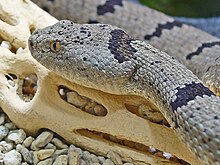Crotalus lepidus klauberi
| Crotalus lepidus klauberi | |
|---|---|

| |
| A Banded Rock Rattlesnake is a Crotalus lepidus klauberi | |
| Scientific classification | |
| Domain: | Eukaryota |
| Kingdom: | Animalia |
| Phylum: | Chordata |
| Class: | Reptilia |
| Order: | Squamata |
| Suborder: | Serpentes |
| Family: | Viperidae |
| Genus: | Crotalus |
| Species: | |
| Subspecies: | C. l. klauberi
|
| Trinomial name | |
| Crotalus lepidus klauberi | |
Crotalus lepidus klauberi is a
.Geographic range
In the United States C. l. klauberi is found in Arizona, New Mexico and Texas.
In Mexico it is found in the Mexican states of Baja California, Chihuahua, Coahuila, Durango, Jalisco, Nuevo León, San Luis Potosí, Sonora, Tamaulipas, and Zacatecas.
Etymology
The specific name or epithet, klauberi, is in honor of American herpetologist and rattlesnake expert Laurence M. Klauber.[5]
Description

Adults rarely grow to more than 24 inches (610 mm) in length. The color pattern is typically a light grey with darker grey banding that varies greatly from habitat to habitat. The background color may be green to purple in some locations. Those found in the Franklin Mountain range of El Paso County in Texas are unique, having a striking pearl silver background and well defined black crossbands.
The characters used to distinguish the various
Common names
Banded rock rattlesnake,[2] blue rattlesnake, green rattlesnake, green rock rattlesnake, rock rattlesnake.[3]
Behavior
These are
In contrast to the shyness described above, Banded Rock Rattlesnake specimens found high (>7000 ft) in the Organ Mountains of southern New Mexico are usually highly confident and defensive, rattling incessantly at the mere sight of humans. One often has to search carefully for the source of the rattling, because they are indeed expert at hiding themselves in small caves and cracks in rocky terrain.
Reproduction
References
- ISBN 1-893777-01-4(volume).
- ^ ISBN 0-394-50824-6. (Crotalus lepidus klauberi, p. 689 + Plate 640).
- ^ ISBN 0-8014-0463-0. (Crotalus lepidus klauberi, pp. 969-973, Figure 277, Map 68).
- ^ "Crotalus lepidus klauberi". Integrated Taxonomic Information System. Retrieved 16 May 2007.
- ISBN 978-1-4214-0135-5. (Crotalus lepidus klauberi, p. 143).
Further reading
- ISBN 0-520-21056-5.
External links
- Crotalus lepidus at the Reptarium.cz Reptile Database. Accessed 12 December 2007.
- Crotalus lepidus at University of Texas. Accessed 12 December 2007.
- Banded rock rattlesnake Archived 2006-03-16 at the Wayback Machine at American Int'l Rattlesnake Museum. Accessed 12 December 2007.
